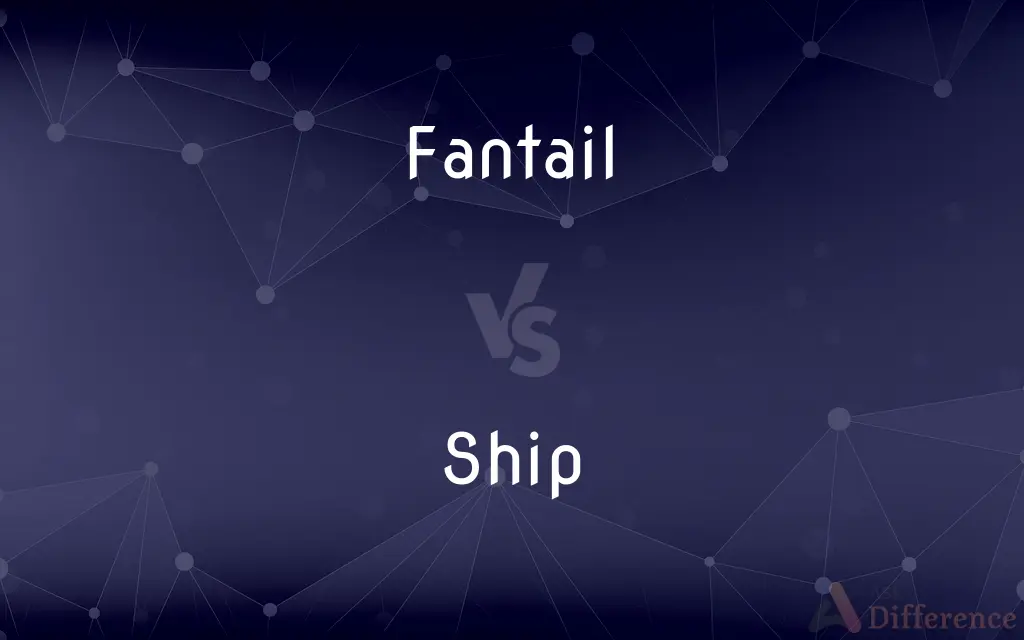Fantail vs. Ship — What's the Difference?
By Maham Liaqat & Urooj Arif — Updated on May 2, 2024
A fantail is the rounded stern section of a ship, enhancing stability and aesthetics, while a ship is a large watercraft designed for maritime transport, comprising various structures including the fantail.

Difference Between Fantail and Ship
Table of Contents
ADVERTISEMENT
Key Differences
A fantail specifically refers to the aft part of a ship, characterized by its rounded, often overhanging shape that aids in stability and aesthetic design. Whereas a ship is a broad term for any large watercraft designed for maritime travel or transport, incorporating numerous structural components such as the bow, stern, decks, and the fantail itself.
The design of the fantail can affect the ship's hydrodynamics, improving water flow and propulsion efficiency. On the other hand, the overall design of a ship determines its suitability for different maritime tasks, like cargo transport, passenger travel, or naval operations.
The fantail often serves specific functional purposes beyond aesthetics, such as housing equipment like capstans or steering gear. Conversely, the ship encompasses all these systems, including navigation, propulsion, and living quarters, integral for its operation.
While the fantail is an essential part of many ships, especially those with classical designs, modern ships might have different stern configurations tailored to their specific needs. In contrast, contemporary ships vary greatly in size, type, and function, reflecting advancements in maritime technology and changing transportation needs.
Comparison Chart
Definition
Rounded stern part of a ship
Large watercraft for maritime transport
ADVERTISEMENT
Function
Enhances stability, aesthetics, and hydrodynamics
Transports goods, people; conducts naval missions
Location
Always at the stern
Encompasses all parts including the fantail
Variability
Mostly uniform in design but varies in size
Highly variable in design, size, and function
Usage in Context
Part of ship structure
Whole maritime vehicle
Compare with Definitions
Fantail
Typically found on naval and commercial ships.
Sailors gathered at the fantail to enjoy the sea breeze.
Ship
Designed for specific maritime tasks.
This passenger ship includes luxurious amenities for long voyages.
Fantail
Rounded or overhanging part of a ship’s stern.
The fantail of the yacht was elegantly designed for added aesthetic appeal.
Ship
Incorporates multiple structural components including the fantail.
The ship’s design featured a modern fantail that enhanced propulsion.
Fantail
Enhances a ship's stability and hydrodynamics.
The ship’s fantail was modified to improve its sea-keeping qualities.
Ship
Large vessel built for ocean travel or transport.
The cargo ship can carry over two thousand containers.
Fantail
Can house maritime equipment.
The fantail was equipped with a new set of capstans for better cargo handling.
Ship
Comes in various types such as cargo, passenger, and military.
The naval ship is equipped with advanced radar and weaponry.
Fantail
Often used for decorative purposes in historical ships.
The fantail featured intricate carvings that highlighted the ship’s grandeur.
Ship
Operates globally across different waters.
The ship embarked on a global journey covering multiple continents.
Fantail
Fantails are small insectivorous birds of Australasia, Southeast Asia and the Indian subcontinent belonging to the genus Rhipidura in the family Rhipiduridae. Most of the species are about 15 to 18 cm long, specialist aerial feeders, and named as "fantails", but the Australian willie wagtail is a little larger, and, though still an expert hunter of insects on the wing, concentrates equally on terrestrial prey.
Ship
A ship is a large watercraft that travels the world's oceans and other sufficiently deep waterways, carrying goods or passengers, or in support of specialized missions, such as defense, research, and fishing. Ships are generally distinguished from boats, based on size, shape, load capacity, and tradition.
Fantail
A fan-shaped tail or end.
Ship
A vessel of considerable size for deep-water navigation.
Fantail
A domestic pigeon of a broad-tailed variety.
Ship
A sailing vessel having three or more square-rigged masts.
Fantail
A flycatcher with a long tapering tail that is often fanned out, found mainly in SE Asia and Australasia.
Ship
An aircraft or spacecraft.
Fantail
Any of a breed of domestic pigeons having a rounded, fan-shaped tail.
Ship
The crew of one of these vessels.
Fantail
Any of several birds of the genus Rhipidura of eastern Asia and Australia, having a long, fan-shaped tail.
Ship
One's fortune
When my ship comes in, I'll move to a larger house.
Fantail
Any of a breed of goldfish having a wide, fanlike double tail fin.
Ship
To place or receive on board a ship
Shipped the cargo in the hold.
Fantail
A fanlike tail or end.
Ship
To cause to be transported; send.
Fantail
(Nautical) The stern overhang of a ship.
Ship
(nautical) A water-borne vessel generally larger than a boat.
Fantail
Any of several birds, of the genus Rhipidura, from Asia, Australia and New Zealand.
Ship
A vessel which travels through any medium other than across land, such as an airship or spaceship.
Fantail
Any of several domestic varieties of pigeon having a fan-shaped tail.
Ship
A spaceship (the type of pattern in a cellular automaton).
Fantail
Any of several goldfish having a large fan-shaped tail.
Ship
A sailing vessel with three or more square-rigged masts.
Fantail
(nautical) An overhanging deck at the stern of a ship.
Ship
A dish or utensil (originally fashioned like the hull of a ship) used to hold incense.
Fantail
A small windmill mounted at right angles to the sails, at the rear of the windmill, used to turn the cap automatically to bring it into the wind.
Ship
(cartomancy) The third card of the Lenormand deck.
Fantail
A brimmed hat with just the back of the brim turned up.
Ship
(dated) An aircraft.
Fantail
A variety of the domestic pigeon, so called from the shape of the tail.
Ship
(fandom) A fictional romantic relationship between two characters, either real or themselves fictional, especially one explored in fan fiction.
Fantail
An overhang consisting of the fan-shaped part of the deck extending aft of the sternpost of a ship
Ship
(transitive) To send by water-borne transport.
Ship
(transitive) To send (a parcel or container) to a recipient (by any means of transport).
To ship freight by railroad
Ship
(ambitransitive) To release a product (not necessarily physical) to vendors or customers; to launch.
Our next issue ships early next year.
It compiles? Ship it!
Ship
(ambitransitive) To engage to serve on board a vessel.
To ship seamen
I shipped on a man-of-war.
Ship
(intransitive) To embark on a ship.
Ship
To put or secure in its place.
To ship the tiller or rudder
Ship
(transitive) To take in (water) over the sides of a vessel.
We were shipping so much water I was sure we would capsize.
Ship
Leave, depart, scram.
Ship
To pass (from one person to another).
Can you ship me the ketchup?
Ship
To go all in.
Ship
(sports) To trade or send a player to another team.
Twins ship Delmon Young to Tigers.
Ship
(rugby) To bungle a kick and give the opposing team possession.
Ship
(fandom) To support or approve of a fictional romantic relationship between two characters, typically in fan fiction or other fandom contexts.
I ship Kirk and Spock in “Star Trek”.
I ship Peggy and Angie in “Marvel's Agent Carter”.
Ship
Pay; reward.
In withholding or abridging of the ship or the hire or the wages of servants.
Ship
Any large seagoing vessel.
Like a stately ship . . . With all her bravery on, and tackle trim,Sails filled, and streamers waving.
Thou, too, sail on, O Ship of State!
Ship
Specifically, a vessel furnished with a bowsprit and three masts (a mainmast, a foremast, and a mizzenmast), each of which is composed of a lower mast, a topmast, and a topgallant mast, and square-rigged on all masts. See Illustation in Appendix.
Ship
A dish or utensil (originally fashioned like the hull of a ship) used to hold incense.
Ship
To put on board of a ship, or vessel of any kind, for transportation; to send by water.
The timber was . . . shipped in the bay of Attalia, from whence it was by sea transported to Pelusium.
Ship
By extension, in commercial usage, to commit to any conveyance for transportation to a distance; as, to ship freight by railroad.
Ship
Hence, to send away; to get rid of.
Ship
To engage or secure for service on board of a ship; as, to ship seamen.
Ship
To receive on board ship; as, to ship a sea.
Ship
To put in its place; as, to ship the tiller or rudder.
Ship
To engage to serve on board of a vessel; as, to ship on a man-of-war.
Ship
To embark on a ship.
Ship
A vessel that carries passengers or freight
Ship
Transport commercially
Ship
Hire for work on a ship
Ship
Go on board
Ship
Travel by ship
Ship
Place on board a ship;
Ship the cargo in the hold of the vessel
Common Curiosities
What are some common types of ships?
Common types of ships include cargo ships, passenger ships, and naval ships.
How does the design of a fantail affect a ship?
The fantail design can improve a ship’s hydrodynamics, affecting its efficiency and stability in water.
How does a ship differ from a boat?
A ship is larger, designed for deep-water travel, whereas a boat is smaller and operates in shallower waters.
What materials are used to build a ship?
Ships are typically made from steel and other durable materials to withstand harsh maritime conditions.
Is the fantail crucial for the ship's operation?
While not crucial, the fantail plays a significant role in the ship’s overall aesthetics and some functional aspects.
What features are typically found on a ship's fantail?
Features on a fantail can include equipment like capstans, steering gear, and sometimes recreational spaces.
What are the main purposes of a ship?
Ships are primarily used for transporting goods and people, or for military purposes.
What is the historical significance of the fantail?
Historically, fantails were often elaborately designed to display wealth and power in naval and commercial fleets.
Can all ships be said to have a fantail?
Not all modern ships have a fantail; some have different stern designs depending on their specific functions.
What is a fantail on a ship?
A fantail is the rounded rear section of a ship, enhancing its stability and aesthetics.
Share Your Discovery

Previous Comparison
Paint vs. Colour
Next Comparison
Array vs. PointerAuthor Spotlight
Written by
Maham LiaqatCo-written by
Urooj ArifUrooj is a skilled content writer at Ask Difference, known for her exceptional ability to simplify complex topics into engaging and informative content. With a passion for research and a flair for clear, concise writing, she consistently delivers articles that resonate with our diverse audience.













































